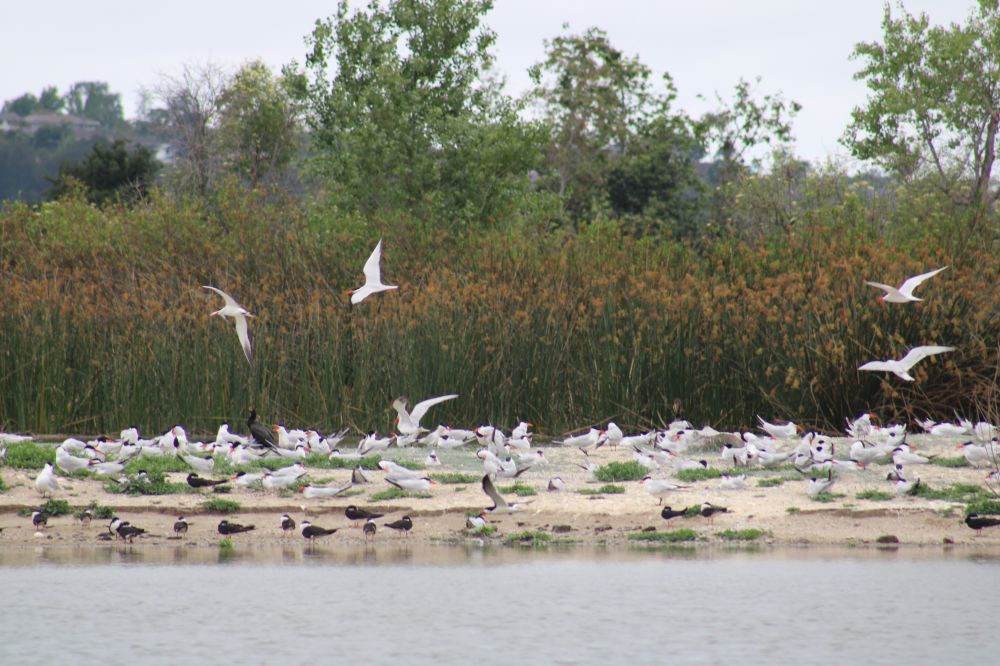暖冬cool夏
这里一年四季温暖如春,没有酷暑没有严寒......某宅男喜欢引用别人说的“旅游就是从自己活腻呆腻的地方去人家活腻呆腻的地方”来证明宅家的好,旅行没必要,加上小宅女不在家,两老宅男老宅女更是双双宅在家中。
那就看看家门口的风景吧。
今年这里春夏之交的天气异常,冷,六十多度,阴天一日接一日,阴的让人想起江南的春天,让人不敢相信这是生活在四季阳光的加州。
长周末三天都是阴天,夜间下雨,白天天空还偶尔会飘起雨丝。周日、周一两天宅女拉着宅男去了一趟附近水厂边上的湿地公园,那里有七个用来过滤脏水废水的池塘。渐渐地,有水的地方变成了鸟类栖息的天堂,大鸟小鸟,外来鸟本地鸟,据统计大约有200多种鸟类聚集于此生息繁衍。
看图:鸟儿栖息在池塘中央,离的有些远, 只能拍到这么清楚, 相机不够好:)这个岛上现在聚集的大多是一种叫skimmer的鸟, 黑色和白色两种,红红的尖嘴捕鱼时像把剪刀从水面划过:


Osprey 鱼鹰,在高高的木架上孵养baby. 也离得很远,近处被绳索拦住进不去。

那日,一侧的路口封了,两人只好走上入口外另一侧的河堤。路面是铺着小石子的石子路,路的右侧是一个大斜坡,放眼望去,只见斜坡上倒满了各种碎石,碎石下面是裸露的河床和一些巨石,把窄窄的小溪拦在巨石的那一边。小溪的另一端长着一片高高的类似芦苇的河草。下午时分,水面很安静,除了几只黑水鸟浮在水面,两只白鹭立在两侧,大多数水鸟鸭子都在岸边休息,远没有两个月前涨满溪水时水面的欢腾和热闹景象。
不过,常在河边走就有了新发现。正走着有点百无聊赖,侧前方走来一只不太常见的鸟,在斜坡下那一大片乱石中移动。某人立马端起脖子上挂的大相机咔嚓咔嚓地照着。小鸟貌似一点不怕人,还越走越近,最后站在离我们只有几步之遥的斜坡上一动不动。某人通过大相机拉近的镜头发现了鸟脚下的四个蛋蛋,灰灰的蛋壳上布满着黑点,与裸露在日光下的乱石混为一体。
有图有真相。小鸟走上斜坡:

鸟站着一动不动,脚下四个蛋:

拉近距离,眼睛红红的:
原来如此。
回家后上网查得,这是一种叫Killdeer的鸟,是以它发出的叫声命名。这种鸟喜欢把蛋生在乱石中,并靠近水源,因为孵出来的小鸟先会游泳,然后才学会飞。
这是此行的一大收获。但愿鸟宝宝能安全孵出,为大自然增添四个新生命!
顺便还拍了一些入口处的花草树木。
Silk Oak,native to Australia: 丝绒橡树


木棉花

木棉树上的树结,像刻着一双眼睛:

再来一张更清楚:
好像是Purple Verbena Bonariensis Lollipop
还没有查到名字:

California Tree poppy (加州树罂粟)花瓣像纸皱的白裙


Purple Sage Salvia 紫洋蘇草花

Hot lips salvia (Mint family): 烈焰红唇
Cotton wood (飘白絮的棉树)

公园门口,五月底的黑莓还是青的,家中后院的已经开始黑了成熟了。

猜一猜下图是什么?
周日晚上把这些照片贴在微信的moments里,附上跟这篇文章标题一样的一句话。第二天一位朋友留言问,“什么新招术?” 原来沉浸在AI世界里的她,误以为我这些照片是用AI模拟出来的。

这世界越来越小。或许某一天人类真的可以通过AI模拟出虚幻世界,让我们足不出户,便可以地“走”遍全世界,便可以“身”临其境地体验世界各地的风光。这样,人类该不会觉得“活腻呆腻”了吧:)
有没有这样的一天尚不可知也。不过,AI的精彩世界却指日可待!(或是已经轰轰烈烈,君不见前几日AI的领头羊股票一日涨20%多:))
On an overcast day at the end of May, Em chose to go to a nearby park, a constructed 300- acre wetland nestled in the busy city. Disguised as a nature preserve, the park in reality is a water filter facility, where ponds and plants are used to filter the dirty water before circulating back for irrigation or to the sea. Then ponds become home to birds, migrating or local birds, ranging from big pelicans, Canadian geese to little hummingbirds. Ospreys breed their babies on the high man-built platform. In a bustling city that is surrounded by more and more concrete buildings, this marsh land is a getaway to Em.
The blackberries sprawled at the entrance that Em came for were unfortunately not ready for picking, weeks away from ripening. And the trail to the park on the side was close. That left Em with little choice but to stroll around the only open area in the front, where one towering Silk Oak and two or three Cotton trees form an overarching canopies. Native to Australia, the Silk Oak lights up to the sky with its golden orange blooms. The Cotton trees hanging white cotton balls are exotic too. Walking out of the shade, Em was greeted by vibrantly blooming California Tree Poppies. The abundant rains this year brought forth their fullest splendor, higher bushes and more flowers with bigger petals. A close look at its white petals reminds Em of crinkled crepe paper. Interstingly, its golden yellow stamens earn itself a vivid nickname “Fried egg" plant.
Getting out of the park, Em and her husband decided to walk a bit farther to the end of an overpass that they never reached before. Sauntering along the gravelly bank overlooking a creek was joyful. It’s around three o’clock in the afternoon. The sky was gloomy, and the temperature was in 60s. To the right of the trail leading down to the creek are long steep slopes piled with small gravels, scattered occasionally with some trashes drifted down from the upper stream. The creek was peaceful at the time, no surging water and not many birds on, only a few American coots floating on the surface. Ducks were resting on the marsh by the side, two white herons standing apart on each end.
Out of this quietness came along a brown and whitish bird, ascending a rocky slope, who showed no sign of retreat, even when a lady and a dog from the opposite direction joined the narrow trail.
The bird was then just a stone’s throw away. He put down the camera and in a low voice told Em that there were eggs underneath. Em grabbed the camera and zoomed in by herself. Peering hard through the lens, she saw four gray eggs with black little dots, lying in the depression of rocks between the two feets of the standing bird. She would have missed them had it been the camera and his guidance.
“How could a petite bird produce such four big eggs?” Em thought out loud.
“It must be a pain in the ass,” he joked in English.
“And why she laid the eggs here among the mere rocks, without any protection?” wondered Em.
Further research at home eased Em’s worry, in the knowledge that the bird, named as Killdeer, prefers the habitat where rocks mix well with its camouflaged eggs, and that as soon as the baby birds are hatched, they could swim in the creek next to them.
Isn’t nature full of wonders!
很多年前刚搬进来时种了好几棵玫瑰,后来都被我种死了。今年自家种的玫瑰终于开花,带着浓郁的花香,花瓣层层叠叠,很喜欢!说了,哪一天把火龙果砍了,让玫瑰攀沿上位:))
5/30/2023拍的

5/31/2023拍的






谢谢亲儿用二种文字把我们带到温暖灵动的生活。
话说回来,你家门口那么多好风景,是可以做借口不需远行的。有湖有鸟,奇树异花,有些景色是大太阳下看不到的。
暖冬周末快乐!
英雄所见略同啊:)
It is “pelicans“ instead of “paragons“, and it is American coots. Thank you for pointing them out, and thank you for liking the pictures and the post. I like them too:) Happy June!
Why the peregrine is called the Paragon falcon?
Did you mean American coots?
Great post. Thanks for sharing.
加州是奇花异草最多的,估计是拜阳光所赐和它广袤的地貌,我也是渐渐感兴趣地去了解它们。这鸟据说跟人很亲近,不怕人,有它的生存之道。
加州阳光都跑你们那里去了,一个多星期了,天天阴天,今天还阴。你们好好享受阳光好好享受初夏的纽约!Oncemm六月快乐!
我家后院太小,阳光不足,玫瑰只有攀上去才能盛开得更好,而我就只有这个地方有个架子,所以如果今年玫瑰健健康康,火龙果可能以后就要牺牲了,不像你家后院这么大,瓜果飘香的,很羡慕啊!谢谢小小的留言,六月快乐!
那些小花仔细看也很漂亮,烈焰红唇见过,不知道叫这名字:)还有飘白絮的棉树,今天在暖冬这里见到这么多奇花异草,长见识了!:))
千万别把火龙果给砍了,与玫瑰共存啊,边吃火龙果边欣赏玫瑰,是双重享受撒!:))
暖冬六月快乐!